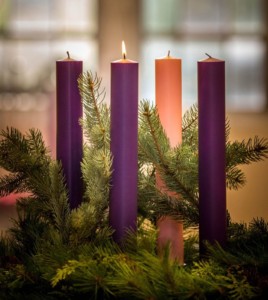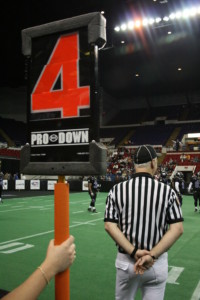Welcome to TOB Tuesdays Refreshed. Over the next few months we will revisit Katrina’s past blogs followed by Jack Henz’* reflection.
The 4 Comings of Christ by Katrina J. Zeno, MTS
Welcome to TOB Tuesdays! My name is Katrina Zeno and every week we’ll spend a few minutes reflecting on an aspect of St. John Paul II’s monumental work, Man and Woman He Created Them, otherwise known as the “Theology of the Body.” Today’s topic is, “The 4 Comings of Christ.”
 If you made it through last week’s blog on “Christmas is a Wedding!” I’d like to pump your arm up and down in a vigorous handshake and congratulate you. We tackled one of the toughest topics in all of Christianity, and, in fact, in the whole history of humankind – how the infinite, spiritual God became finite and material without compromising His Divinity or decimating humanity.
If you made it through last week’s blog on “Christmas is a Wedding!” I’d like to pump your arm up and down in a vigorous handshake and congratulate you. We tackled one of the toughest topics in all of Christianity, and, in fact, in the whole history of humankind – how the infinite, spiritual God became finite and material without compromising His Divinity or decimating humanity.
Fortuitously, your blood, sweat, and tears from last week will bear much fruit this week (I hope).
Have you ever asked yourself, “Why is Advent 4 weeks long?” Why not 40 days or nine days? Those are both very liturgical and Catholic numbers. I imagine there are various reasons why Advent is 4 weeks long, but I want to reflect on just one of them – the 4 Comings of Christ.
When we light the first purple candle, it represents the First Coming of Christ, the one that is most obvious: the Incarnation, God coming among us in the flesh. But, as we saw last week, this coming of Christ has a very particular shape – the shape of the Bridegroom (Jesus Christ) united to the Bride (human nature) in a Union and Holy Communion. Christmas is a wedding!
Then what about the second week of Advent and the second purple candle? What Coming of Christ does that represent? The second week reminds us of how Jesus, the Divine Bridegroom, continues to come among us every day in the Eucharist.
The second week reminds us of how Jesus, the Divine Bridegroom,
continues to come among us every day in the Eucharist.
The Eucharist is also a wedding! It is also a Union and Holy Communion between Bridegroom and Bride. However, in this “wedding,” you are the bride. Every time you approach the altar, the priest holds up the Eucharist and says, “The Body of Christ,” and you say, “Amen! I believe!” You profess that you believe what you are about to receive is not simply a white wafer nor merely symbolic, but the Body, Blood, Soul, and Divinity of God. And reverently you receive the Body of Christ into your body and for a few precious moments, your body and the Body of Christ are united in a Union and Holy Communion reminiscent of the Incarnation. The second coming of Christ to us in the Eucharist is also a wedding!
How about the Third Coming of Christ – the pink candle? This is the candle of joy, of Gaudete Sunday that proclaims, “Rejoice in the Lord always; I say it again, rejoice!” (Phil. 4:4) Not only does Jesus come to us in history through the Incarnation and every Sunday (even daily!) through the Eucharist, but He also comes into each of our lives to take us away to the place He has prepared for us in His Father’s House (see John 14:2-3). Yes, I’m speaking about death, your death.
At this point, you might say to me, “Wait, wait, Katrina. That doesn’t sound very joyful. How can death be cause for rejoicing?” But then we can recall Jesus’ words to Martha about her brother Lazarus’ death: “…he who believes in me, though he die, yet shall he live, and… shall never die” (John 11:25-26).
This third candle is brimming over with joy because Jesus has conquered death. At the Easter Vigil we proclaim, “Christ has trampled down death by death!” Death is not the end, but merely the passage way – perhaps we could say the “rehearsal dinner” – that ushers the Bride, the wise virgin who has kept her lamp of spousal love for God burning brightly, all the way to the Divine Bridal Chamber of heaven!
This third candle is brimming over with joy
because Jesus has conquered death.
Recently, I attended a morning of reflection where I was introduced to Servant of God Chiara Corbella Petrillo. Chiara was born in Rome in 1984 and raised in the Catholic charismatic renewal. Her future husband, Enrico, was also raised in Rome and in the Catholic charismatic renewal. However, they met not in Rome, but in Medjugorje, and were eventually married on September 9, 2008.
A sonogram during Chiara’s first pregnancy revealed a precious little girl with anencephaly, a condition where portions of the brain, skull, and scalp are missing. Their daughter was born, baptized, lived for forty love-saturated minutes, and then was reborn into eternity. Joy flooded Chiara and Enrico’s hearts.
Five months later, Chiara was pregnant again, and a sonogram showed a son who had only 1 leg, no kidneys, and lungs that would never develop. His condition was so rare and complex that it didn’t even have a name. Their son was born, baptized, and died peacefully in the arms of his adoring parents.
A third pregnancy dawned, and this time the sonogram showed a normal, healthy baby. But lesions on Chiara’s tongue heralded the presence of an aggressive form of cancer. Chiara’s doctors pressured her to allow them to deliver the baby early so she could begin chemotherapy, but she resisted. Instead, she insisted that her pregnancy continue to full term. Finally, a healthy baby boy, Francesco, was born.
Chiara’s condition, however, deteriorated. Even as her body wasted away, a luminous light grew more and more intense within her. Barely a year after their son’s birth, Enrico companioned his young wife to the doorstep of death. As her own personal Advent of Christ’s coming to take her home drew near, Enrico announced to his family and friends, “The lamps are lit, and we are waiting for the Spouse.” Chiara died at home on June 13, 2012, dressed in her wedding gown.
Enrico and Chiara joyfully awaited and anticipated the Third Coming of Christ into Chiara’s life, and they were not disappointed. The Bridegroom came and took her home with spousal joy.
If, like Enrico and Chiara, we have the eyes of faith and the joy that surpasses all human understanding, then we can see that our entrance into eternity is also a wedding! We pass through the Holy Door of death and enter into Holy Union and Communion with Christ our Bridegroom forever.
And finally, during the last week of Advent, we wait and anticipate the Fourth Coming of Christ – Christ’s Second Coming as the Bridegroom of all humanity. At the consummation of history, the Returning Bridegroom comes in glory to take His universal Bride, the Church, to be with Him forever. This, too, is a wedding! It is the eternal marriage Supper of the Lamb, an eternal Union and Holy Communion symbolized by the Wedding Feast of the Lamb. Even though we might not realize it, we recall this momentous event at every Mass when the priest holds up the host and chalice and says, “Behold the Lamb of God, behold him who takes away the sins of the world. Blessed are those who are called to the [Marriage] Supper of the Lamb.” (Dr. Ed Sri has a wonderful column posted online at catholicnewsagency.com entitled, The Bride and Bridegroom at the Supper of the Lamb.)
These words of the Mass intentionally echo Revelation 19:9, where an angel instructs St. John to, “Write this: ‘Blessed are those who are invited to the marriage supper of the Lamb.’ ” And the final chapter of the Bible, Revelation 21, verse 20, reverberates with the cry, “Come, Lord Jesus!”
During Advent, and throughout the whole liturgical year, these words should ring from our lips: “Come Lord Jesus come!” Come Divine Bridegroom into our hearts as in the Incarnation! Come into our bodies in the Eucharist! Come into our lives at the moment of our death! And come at the culmination of human history to bring every person to the Eternal Wedding Feast of the Lamb!
What a privilege that the Church gives us four wonderful weeks in Advent to stir up our spousal anticipation for the coming of God in the flesh, to see this baby as the Bridegroom-Messiah who comes leaping over the mountains, bounding over the hills into the stable in Bethlehem to be loved and adored by us, who keep our virginal lamps burning brightly as Chiara and Enrico did.
God wants to be one with us
At the same morning of reflection in which I was introduced to Chiara’s story, the bishop of our diocese, Bishop Thomas J. Olmsted, summarized God’s eternal plan in 7 words: “God wants to be one with us.” May those 7 words reverberate in your heart today, every day, and especially Christmas day – God wants to be one with you. God created you for a Union and Holy Communion with Himself now and forever. And remember…you are a gift!
P.S. If you’d like to listen to a fabulous Advent song, here’s the link to Chris Tomlin’s “Even So Come!” on YouTube: https://www.youtube.com/watch?v=4s0Zb189Sco
(Please “share” this blog – and invite your friends to like the JPII Resource Center FB page. Thank you.)
@Katrina J. Zeno, MTS
Jack Henz’ Reflection: Four Candles and Four Downs
 Shortly after Thanksgiving, my home is overrun by preparations for Christmas, with much of our decorating occurring while football games play in the background. As fourth downs, field goals, tackles, and touchdowns fill the airwaves, we happily decorate the Christmas tree and home, set up our formal Nativity set (including the wandering Three Kings), and arrange the Advent wreath for its daily lighting.
Shortly after Thanksgiving, my home is overrun by preparations for Christmas, with much of our decorating occurring while football games play in the background. As fourth downs, field goals, tackles, and touchdowns fill the airwaves, we happily decorate the Christmas tree and home, set up our formal Nativity set (including the wandering Three Kings), and arrange the Advent wreath for its daily lighting.
This year, a rather fascinating association began to develop in my mind – the similarity between the four weeks of Advent and the four downs in football. Let me explain…
Despite being empty nesters, my wife and I still faithfully light the Advent wreath every day. Before reading Katrina’s Blog #7 on “The Four Comings of Christ,” the meaning of the four candles revolved around hope, faith, joy, and peace – hope in God’s coming in the flesh, faith in our salvation, joy in the anticipated birth of Jesus, and peace in the world once the King of Kings arrives.
However, just as Katrina’s Blog 6 on the Incarnation reordered our thoughts about our Nativity set, Blog #7 prompted a major re-drafting of our understanding of the four weeks of Advent.
We started seeing how the traditional reflections of hope, faith, joy, and peace could be enhanced by reflecting on Christ’s Four Comings: Christ’s coming as Bridegroom in the flesh (first candle – Hope); Christ’s Divine Presence in the Eucharist (second candle – Faith); Christ’s coming for each of us at death to complete our joy and His joy (pink candle – Joy); and Christ’s final coming at the end of time, when He ushers us into the Marriage Supper of the Lamb for all eternity (final candle – Peace).
As we continued lighting the Advent candles throughout the weeks and the football season continued to unfold, a clever thought invaded my mind (or so I hoped): Might it be possible to relate the four downs in football to the four Comings of Christ? Well, here’s my attempt.
First Down: Normally a first down starts a new series of plays for a team to work towards their goal. The Incarnation, however, initiates a completely new series of downs for all of humanity. Through a miraculous “Hail Mary pass,” that is “completed” through Mary’s “reception” of the Word made flesh, every person is given a new chance, a new set of downs, to enter into union and communion with the Trinity through our own “miraculous reception” of the Holy Spirit in Baptism.
Second Down: The second down is pivotal to a team’s successful striving for a singular goal. Our goal is eternal union and communion with the Trinity. By receiving the Eucharist at Mass, we experience an intimate union and communion between God’s divinity and our humble humanity right in our own bodies. During our time on earth, this is as good as it gets – kind of like Super Bowl Sunday every Sunday.
Third Down: This is the deciding play, a figurative “life or death” attempt as we drive towards the goal. But we know that Jesus has already beaten death for us: He has trampled on death by death. If we say “Yes” to Jesus’ love, we are “handed” the gift of eternal life. If we decline, we “leave the playing field,” we could say, until a future “conversion point” where we re-enter the “field” of eternal life in Christ.
If we say “Yes” to Jesus’ love, we are “handed” the gift of eternal life.
If we decline, we “leave the playing field,” we could say, until a future “conversion point”
where we re-enter the “field” of eternal life in Christ.
Fourth Down: Fourth down is the last chance for success. Literally, we’ll face our fourth down at Christ’s Final Coming. We’ll either be worthy of being invited to the Eternal Wedding Feast of the Lamb or face an eternity of hell and separation from Trinitarian Love. The Four Comings of Christ assure us that God never desires even one person to be lost. As Bishop Thomas J. Olmsted summarized in seven words, “God wants to be one with us.” All we have to do is say “Yes!” and stay in the game.
©by Jack Henz
We invite you to share your own 2-3 line reflection on our JPII Resource Center Facebook page by clicking here.
*Jack Henz is a retired meteorologist and a graduate of the Diocese of Phoenix ‘s Kino Catechetical Institute. Together with his wife Karen, he is a passionate catechist concerning all things Catholic, especially the Theology of the Body.




